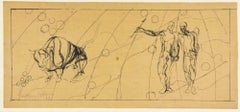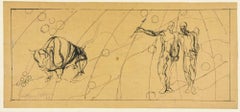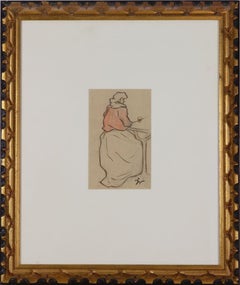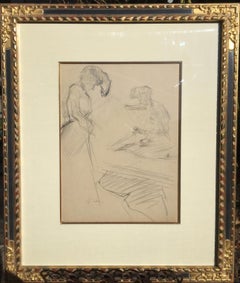Jacques Villon Drawings and Watercolor Paintings
French, 1875-1963
Jacques Villon was born Gaston Duchamp in 1875. He was the oldest brother of the artists Marcel Duchamp, Suzanne Duchamp-Crotti and the sculptor Raymond Duchamp-Villon. Initially a law student, in 1894 he went to Paris to study art. It was there that he met Henri Toulouse-Lautrec and other influential artists in Paris, and changed his name to Jacques Villon, after the poet. Villon made prints of some of the most well-known belle-époque portraits and genre scenes of the early twentieth century. Around 1911, he came under the influence of Picasso and other cubists, and became a leading exponent of the style, exhibiting in the 1913 Armory Show in New York. In 1922, the Galerie Bernheim-Jeune commissioned Villon to produce a series of color aquatints after 38 major nineteenth- and twentieth-century paintings. This series included works by Pierre Auguste Renoir, Henri Matisse, Pablo Picasso, Paul Cezanne, Georges Braque, Raoul Dufy, Amadeo Modigliani, Edouard Manet, Pierre Bonnard, and others. Artists who were alive at the time of the printing collaborated with Villon, and signed the prints. The project took ten years to complete. Several of these prints are valued highly today, and some went on to be reproduced by the Louvre Museum as photo-etchings. Villon's 'cubist' etchings, with their characteristic cross-hatching, are amongst the most renowned prints of the twentieth century. Jacques Villon's long career brought him fame. The diverse nature of his paintings, from end-of-the-century portraits to cubist and abstract styles to graphic works, made him a major figure in twentieth-century art. He was made a Grand Officer of the Légion d'Honneur, and upon his death in 1963, and he was given a state funeral.(Biography provided by Georgetown Frame Shoppe)
to
3
2
3
2
3
2
3
2
Overall Height
to
Overall Width
to
3
1
5
5
3
2
1
5
1
2
1
91
808
412
269
228
5
3
2
1
1
Artist: Jacques Villon
Avant le Bain - Drawing by Jacques Villon - 1926
By Jacques Villon
Located in Roma, IT
Hand signed. From the Countess Anna Laetitia Pecci Blunt Collection. Matting included. Very good condition.
Category
1960s Modern Jacques Villon Drawings and Watercolor Paintings
Materials
Paper, Ink
Signs of the Zodiac - Drawing by Jacques Villon - 1937
By Jacques Villon
Located in Roma, IT
Signs of the Zodiac, Taurus and Gemini is a modern artwork realized by Jacques Villon in 1937.
China ink drawing on paper.
Hand signed and dated on the lower margin.
Vintage frame included in this rare artwork...
Category
1930s Modern Jacques Villon Drawings and Watercolor Paintings
Materials
Ink, Paper
Signs of the Zodiac, Taurus and Gemi - Drawing by Jacques Villon - 1937
By Jacques Villon
Located in Roma, IT
Signs of the Zodiac, Taurus and Gemini is an original modern artwork realized by Jacques Villon in 1937.
China ink drawing.
Hand signed and dated on the lower margin.
Vintage fram...
Category
1930s Modern Jacques Villon Drawings and Watercolor Paintings
Materials
Paper, Ink
Femme Attablee Devant un Verre de Vin
By Jacques Villon
Located in Milwaukee, WI
Signed with estate stamp, J.V. double sided.
6-3/4" x 4-3/4" art
18" x 15-1/4" frame
Jacques Villon (French, 1875 - 1963) French painter, printmaker and illustrator. The oldest of three brothers who became major 20th-century artists, including Raymond Duchamp-Villon and Marcel Duchamp, he learnt engraving at the age of 16 from his maternal grandfather, Emile-Frédéric Nicolle (1830-94), a ship-broker who was also a much appreciated amateur artist. In January 1894, having completed his studies at the Lycée Corneille in Rouen, he was sent to study at the Faculty of Law of the University of Paris, but within a year he was devoting most of his time to art, already contributing lithographs to Parisian illustrated newspapers such as Assiette au beurre. At this time he chose his pseudonym: Jack (subsequently Jacques) in homage to Alphonse Daudet’s novel Jack (1876) and Villon in appreciation of the 15th-century French poet François Villon...
Category
Early 20th Century Jacques Villon Drawings and Watercolor Paintings
Materials
India Ink, Crayon, Pencil
Vielle Femme en Petite Cape
By Jacques Villon
Located in Milwaukee, WI
Signed with stamp, J.V.
7-5/8" x 4-3/4" art
19" x 15-1/4" frame
Jacques Villon (French, 1875 - 1963) French painter, printmaker and illustrator. The oldest of three brothers who became major 20th-century artists, including Raymond Duchamp-Villon and Marcel Duchamp, he learnt engraving at the age of 16 from his maternal grandfather, Emile-Frédéric Nicolle (1830-94), a ship-broker who was also a much appreciated amateur artist. In January 1894, having completed his studies at the Lycée Corneille in Rouen, he was sent to study at the Faculty of Law of the University of Paris, but within a year he was devoting most of his time to art, already contributing lithographs to Parisian illustrated newspapers such as Assiette au beurre. At this time he chose his pseudonym: Jack (subsequently Jacques) in homage to Alphonse Daudet’s novel Jack (1876) and Villon in appreciation of the 15th-century French poet François Villon...
Category
Early 1900s Impressionist Jacques Villon Drawings and Watercolor Paintings
Materials
India Ink, Gouache
Related Items
Les Gilles de Binche - 19th Century Watercolor, Figures Belgian Carnival H Duhem
By Henri Duhem
Located in Marlow, Buckinghamshire
Watercolour on paper circa 1920 by Henri Duhem depicting The Gilles at the Carnival of Binche, Belgium. Signed and titled lower left. This painting is not currently framed but a suit...
Category
Early 20th Century Impressionist Jacques Villon Drawings and Watercolor Paintings
Materials
Watercolor, Paper
The Abduction of the Sabine Women , a Renaissance drawing by Biagio Pupini
Located in PARIS, FR
This vigorous drawing has long been attributed to Polidoro da Caravaggio: The Abduction of the Sabine Women is one of the scenes that Polidoro depicted between 1525 and 1527 on the façade of the Milesi Palazzo in Rome. However, the proximity to another drawing inspired by this same façade, kept at the Ecole des Beaux-Arts, and to other drawings inspired by Polidoro kept at the Musée du Louvre, leads us to propose an attribution to Biagio Pupini, a Bolognese artist whose life remains barely known, despite the abundant number of drawings attributed to him.
1. Biagio Pupini, a Bolognese artist in the light of the Roman Renaissance
The early life of Biagio Pupini, an important figure of the first half of the Cinquecento in Bologna - Vasari mentions him several times - is still poorly known. Neither his date of birth (probably around 1490-1495) nor his training are known. He is said to have been a pupil of Francesco Francia (1450 - 1517) and his name appears for the first time in 1511 in a contract with the painter Bagnacavallo (c. 1484 - 1542) for the frescoes of a church in Faenza. He then collaborated with Girolamo da Carpi, at San Michele in Bosco and at the villa of Belriguardo.
He must have gone to Rome for the first time with Bagnacavallo between 1511 and 1519. There he discovered the art of Raphael, with whom he might have worked, and that of Polidoro da Caravaggio. This first visit, and those that followed, were the occasion for an intense study of ancient and modern art, as illustrated by his abundant graphic production.
Polidoro da Caravaggio had a particular influence on the technique adopted by Pupini. Executed on coloured paper, his drawings generally combine pen, brown ink and wash with abundant highlights of white gouache, as in the drawing presented here.
2. The Abduction of the Sabine Women
Our drawing is an adaptation of a fresco painted between 1525 and 1527 by Polidoro da Caravaggio on the façade of the Milesi Palace in Rome. These painted façades were very famous from the moment they were painted and inspired many artists during their stay in Rome. These frescoes are now very deteriorated and difficult to see, as the palace is in a rather narrow street.
The episode of the abduction of the Sabine women (which appears in the centre of the photo above) is a historical theme that goes back to the origins of Rome and is recounted both by Titus Livius (Ab Urbe condita I,13), by Ovid (Fasti III, 199-228) and by Plutarch (II, Romulus 14-19). After killing his twin brother Romus, Romulus populates the city of Rome by opening it up to refugees and brigands and finds himself with an excess of men. Because of their reputation, none of the inhabitants of the neighbouring cities want to give them their daughters in marriage. The Romans then decide to invite their Sabine neighbours to a great feast during which they slaughter the Sabines and kidnap their daughters.
The engraving made by Giovanni Battista Gallestruzzi (1618 - 1677) around 1656-1658 gives us a good understanding of the Polidoro fresco, allowing us to see how Biagio Pupini reworked the scene to extract this dynamic group.
With a remarkable economy of means, Biagio Pupini takes over the left-hand side of the fresco and depicts in a very dense space two main groups, each consisting of a Roman and a Sabine, completed by a group of three soldiers in the background (which seems to differ quite significantly from Polidoro's composition).
The balance of the drawing is based on a very strongly structured composition. The drawing is organised around a median vertical axis, which runs along both the elbow of the kidnapped Sabine on the left and the foot of her captor, and the two main diagonals, reinforced by four secondary diagonals. This diamond-shaped structure creates an extremely dynamic space, in which centripetal movements (the legs of the Sabine on the right, the arm of the soldier on the back at the top right) and centrifugal movements (the arm of the kidnapper on the left and the legs of the Sabine he is carrying away, the arm of the Sabine on the right) oppose each other, giving the drawing the appearance of a whirlpool around a central point of support situated slightly to the left of the navel of the kidnapper on the right.
3. Polidoro da Caravaggio, and the decorations of Roman palaces
Polidoro da Caravaggio was a paradoxical artist who entered Raphael's (1483 - 1520) workshop at a very young age, when he oversaw the Lodges in the Vatican. Most of his Roman work, which was the peak of his career, has disappeared, as he specialised in facade painting, and yet these paintings, which are eminently visible in urban spaces, have influenced generations of artists who copied them abundantly during their visits to Rome.
Polidoro Caldara was born in Caravaggio around 1495-1500 (the birthplace of Michelangelo Merisi, known as Caravaggio, who was born there in 1571), some forty kilometres east of Milan. According to Vasari, he arrived as a mason on the Vatican's construction site and joined Raphael's workshop around 1517 (at the age of eighteen according to Vasari). This integration would have allowed Polidoro to work not only on the frescoes of the Lodges, but also on some of the frescoes of the Chambers, as well as on the flat of Cardinal Bibiena in the Vatican.
After Raphael's death in 1520, Polidoro worked first with Perin del Vaga before joining forces with Maturino of Florence (1490 - 1528), whom he had also known in Raphael's workshop. Together they specialised in the painting of palace façades. They were to produce some forty façades decorated with grisaille paintings imitating antique bas-reliefs.
The Sack of Rome in 1527, during which his friend Maturino was killed, led Polidoro to flee first to Naples (where he had already stayed in 1523), then to Messina. It was while he was preparing his return to the peninsula that he was murdered by one of his assistants, Tonno Calabrese, in 1543.
In his Vite, Vasari celebrated Polidoro as the greatest façade decorator of his time, noting that "there is no flat, palace, garden or villa in Rome that does not contain a work by Polidoro". Polidoro's facade decorations, most of which have disappeared as they were displayed in the open air, constitute the most important lost chapter of Roman art of the Cinquecento. The few surviving drawings of the painter can, however, give an idea of the original appearance of his murals and show that he was an artist of remarkable and highly original genius.
4. The façade of the Milesi Palace
Giovanni Antonio Milesi, who commissioned this palace, located not far from the Tiber, north of Piazza Navona, was a native of the Bergamo area, like Polidoro, with whom he maintained close friendly ties. Executed in the last years before the Sack of Rome, around 1526-1527, the decoration of Palazzo Milesi is considered Polidoro's greatest decorative success.
An engraving by Ernesto Maccari made at the end of the nineteenth century allows us to understand the general balance of this façade, which was still well preserved at the time. The frescoes were not entirely monochrome, but alternated elements in chiaroscuro simulating marble bas-reliefs and those in ochre simulating bronze and gold vases...
Category
16th Century Old Masters Jacques Villon Drawings and Watercolor Paintings
Materials
Ink, Gouache, Pen
'Woman With Yellow Bird' Original Drawing Acrylic And Ink On Paper
Located in Carmel, CA
Inspired by the theatre world, Devie had retained her own unique drawing strokes. Her works reflect an approachable other-worldliness. She paints a story to be told and answered.
Th...
Category
21st Century and Contemporary Modern Jacques Villon Drawings and Watercolor Paintings
Materials
Acrylic, Ink, Handmade Paper
Modern Figurative Surrealist Watercolor Painting, Drawing 'Prince of Innocence'
By Gary Hansmann
Located in Surfside, FL
Angelic boy with a devil figure.
Gary Hansmann (1947-2008) was active/lived in California. He is known for abstract, Surrealism figure painting.
Gary William Hansmann was born Dec. 4, 1940, in San Diego to Ethel May Williams and Lester Hughes Hansmann. He grew up in Encinitas and served in the Army in the early 1960s.
Gary Hansmann, San Diego artist, teacher and gallery owner, was known for his Surrealist drawings and graphics. He spent time working in Paris and exhibiting his art throughout Europe, but San Diego was home until he moved to Washington state. His life partner was fellow artist, Jill Hosmer. Mr. Hansmann, a respected printmaker and prolific artist, created thousands of drawings, prints and paintings as well as hundreds of poems. His interest in bullfighting led to a book of poetry and illustrations on the subject, “La Corrida, The Run”, a collection of poetry & artwork written as he was preparing for his first bullfight. Prologue written by famous Mexican Matador Antonio Lomelin. The book is written in English and translated into Spanish on opposing pages and was published in 1983. Mr. Hansmann taught intaglio and monotype at the Academy of Fine Arts in San Diego from 1977 to 1980 and at the San Diego Museum of Art in 1980. He also gave lectures and demonstrations throughout the art community, including at the San Diego Art Guild in Del Mar and Artist Equity in San Diego. Although he attended Palomar College in San Marcos and studied lithography at the San Diego Academy of Fine Arts, Mr. Hansmann was mostly self-taught and self-educated. Mr. Hansmann had shows in several art-world capitals, including Paris; Lisbon, Portugal; Cologne, Germany; Brussels, Belgium; and New York. he had one-person exhibits at the Loft Gallery in Clarkston, the Lewis-Clark State College Center of Arts & History, the Carnegie Art Center in Walla Walla and the Valley Art Center in Clarkston. During his long, distinguished career as an artist he had numerous one-person exhibits all over the world and the United States.
His group shows are too numerous to mention, but his one-person exhibits were in Koln, Germany; Bruxelles, Belgium; Paris, France; Viana do Castelo, Portugal; Lisbon, Portugal; Tecate, Mexico; and British Columbia, Canada; and many states at home.
Palomar College, San Marcos, Calif.
San Diego Academy of Fine Arts
Brooklyn Museum, Brooklyn, N.Y.
University of Southern California, Idyllwild (ISOMATA)
University of San Diego
San Diego Museum of Art
James Copley Library, La Jolla, Calif.
Biblioteca Nazionale Marciana, Venice, Italy
Centre de Arte Moderna
Gulbenkian Foundation, Lisbon, Portugal
Museo Taurino de la Communidad de Madrid, Madrid, Spain
Atelier Lacouriere et Frelaut, Paris, France
Gordon Gilkey Collection
Portland Art Museum, Portland, Or.
Coos Art Museum, Coos Bay...
Category
1980s Surrealist Jacques Villon Drawings and Watercolor Paintings
Materials
Paper, India Ink, Watercolor
Chef Lobster - Vintage Illustration in Ink and Watercolor
By Irene Pattinson
Located in Soquel, CA
Chef Lobster - Vintage Illustration in Ink and Watercolor
A charming illustration, by Irene Pattinson (American, 1909-1999), shows a pink lobster behind ...
Category
1950s American Modern Jacques Villon Drawings and Watercolor Paintings
Materials
Watercolor, Paper, India Ink, Pen
H 8.5 in W 11 in D 0.25 in
Chef Pasta - Vintage Illustration in Ink and Watercolor
By Irene Pattinson
Located in Soquel, CA
Chef Pasta - Vintage Illustration in Ink and Watercolor
A charming illustration, by Irene Pattinson (American, 1909-1999), shows a chef in an 1800's toque blanche, pouring oil from an ornate bottle over a bowl. His face, with spectacles, a moustache and goatee in fine line work, is painted in vibrant pink watercolor for an added splash of color.
Signed in the bottom right corner, "i.p."
Presented in a new white mat with foam core backing.
Mat size: 8.5"H x 11"W
Paper size: 6.75"H x 6.75"W
Image size: 4.13"H x 3.63"W
Irene Pattinson (American, 1909-1999) studied at the California School of Fine Art (now The San Francisco Art Institute), San Francisco State College and The Marion Hartwell School of Design. She was President of the San Francisco Woman Artists Association 1955-56.
Provenance: The Artist, Estate of Irene Pattinson: David Carlson; Estate of Larry Miller Fine Art, Robert Azensky Fine Art.
Solo Exhibitions: Lucien Labaudt Gallery 1955; San Francisco Museum of Art, 1961 (39 works).
Selected Group Exhibitions: San Francisco Art Association Annual 1948, 54, 55; San Francisco Woman Artists, 1957-1960; Oakland Art Museum Annual, 1951, 58; California Palace of the Legion of Honor, 1960; Richmond Art Center, 1955, 56, 57, 58; San Francisco Art Institute 1959, 60. The Art Bank of the San Francisco Art Association, 1958, 59, 60, 62, 63; Winter Invitational, California Palace of The Legion of Honor, San Francisco, 1960; Fourth Winter Invitational, California Palace of The Legion of Honor, San Francisco, 1963.
Awards: First Place, San Francisco Woman Artists Assoc., 1957, 1959; San Francisco Art Festival 1957;Literature: San Francisco Art Institute - A catalog of the Art Ban 1962/63; San Francisco and the Second Wave: The Blair Collection
Exhibitions:
1963 The Art Bank of the San Francisco Art Association, San Francisco, CA
1963 California Palace of The Legion of Honor: Forth Winter Invitational, San Francisco, CA
1962 The Art Bank of the San Francisco Art Association, San Francisco, CA
1961 San Francisco Museum of Art, San Francisco, CA
1960 California...
Category
1950s American Modern Jacques Villon Drawings and Watercolor Paintings
Materials
Paper, India Ink, Watercolor, Pen
H 11 in W 8.5 in D 0.25 in
"Flower Stand S.F. 1954" - Vintage Illustration
By Irene Pattinson
Located in Soquel, CA
"Flower Stand S.F. 1954" - Vintage Illustration
This detailed ink drawing by Irene Pattinson (American, 1909-1999), shows a charming San Francisc...
Category
1950s American Modern Jacques Villon Drawings and Watercolor Paintings
Materials
Paper, India Ink, Pen
Pigs on a Trolley - Vintage Picture Book Two-Page Spread Illustration
By Irene Pattinson
Located in Soquel, CA
Pigs on a Trolley - Vintage Picture Book Two-Page Spread Illustration
A two-page spread in India ink pen and watercolor by Irene Pattinson (Ameri...
Category
1950s American Modern Jacques Villon Drawings and Watercolor Paintings
Materials
Paper, India Ink, Watercolor, Pen
H 17 in W 30 in D 0.25 in
Study of woman in bathing suit - Ink drawing - circa 1916
By Georges Conrad
Located in Paris, FR
Georges CONRAD (1874-1936)
Study of woman in bathing suit
Original India ink and color pencil drawing
Signed with the stamp of atelier
On paper 26.5 x 20 cm (c. 10.4 x 7.8 in)
Ver...
Category
1910s Academic Jacques Villon Drawings and Watercolor Paintings
Materials
Color Pencil, India Ink
Scene of Venetian evenings during the Carnival - Ink drawing - circa 1916
By Georges Conrad
Located in Paris, FR
Georges CONRAD (1874-1936)
Scene of Venetian evenings during the Carnival
Original India ink and color pencil drawing
Signed with the stamp of atelier
On paper 26.5 x 20 cm (c. 10....
Category
1910s Academic Jacques Villon Drawings and Watercolor Paintings
Materials
Color Pencil, India Ink
Norman Barr, Delancey Street (NYC)
By Norman Barr
Located in New York, NY
Norman Barr recorded his beloved New York City from the Bronx, to Coney Island, to the Fulton Fish Market.
In this period he was on the New Deal's Mural ...
Category
Mid-20th Century Ashcan School Jacques Villon Drawings and Watercolor Paintings
Materials
India Ink, Crayon
Statue of an Ascetic (The Hermit) - Figurative Landscape
By Theodore Ernest Langguth
Located in Soquel, CA
A vintage watercolor capturing a statue of an ascetic in a garden by Theodore Ernest Langguth (German-American, 1861-1952). 1915-20. Signed "T. Langguth" in lower left. Presented in ...
Category
Early 20th Century American Impressionist Jacques Villon Drawings and Watercolor Paintings
Materials
Laid Paper, Watercolor
H 18.5 in W 10.5 in D 0.5 in
Previously Available Items
Illustration for Courier Francais
By Jacques Villon
Located in Santa Monica, CA
Jacques Villon
ILLUSTRATION FOR "COURIER FRANCAIS" 1905
Original Drawing for "Courier Francais", Signed and dated in pencil.
Annotated at the sheet edge 'pour Courier Francais, 190...
Category
Early 1900s French School Jacques Villon Drawings and Watercolor Paintings
Materials
Pencil, Graphite
Marchand D'Art (The Art Dealer)
By Jacques Villon
Located in Saint Augustine, FL
An original signed Mixed Media: Indian Ink ,Watercolor, and Crayon drawing by French artist Jacques Villon (1875-1963) titled "Marchand D'Art (The Art Dealer...
Category
19th Century Impressionist Jacques Villon Drawings and Watercolor Paintings
Materials
Crayon, India Ink, Watercolor
Jacques Villon drawings and watercolor paintings for sale on 1stDibs.
Find a wide variety of authentic Jacques Villon drawings and watercolor paintings available for sale on 1stDibs. You can also browse by medium to find art by Jacques Villon in ink, india ink, paper and more. Much of the original work by this artist or collective was created during the 20th century and is mostly associated with the modern style. Not every interior allows for large Jacques Villon drawings and watercolor paintings, so small editions measuring 15 inches across are available. Customers who are interested in this artist might also find the work of Aristide Maillol, Ernest Rouart, and Maurice Chabas. Jacques Villon drawings and watercolor paintings prices can differ depending upon medium, time period and other attributes. On 1stDibs, the price for these items starts at $6,266 and tops out at $22,680, while the average work can sell for $9,915.








